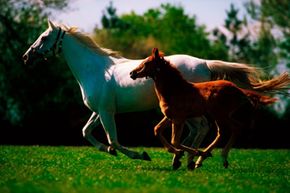The Jockey Clubs: Rules of the Thoroughbred
The Thoroughbred registries around the world don't simply input live birth information for Thoroughbred foals. As we've seen, Thoroughbred stud books are closed registries, meaning they include only purebred Thoroughbreds born to purebred sires and dams. There are a great many rules and conditions a foal must meet to be accepted into a stud book. Since these rules establish the very definition of the Thoroughbred, this means the keepers of the stud books are also the de facto authorities over the breed itself.
The original Jockey Club has been in charge of regulating the breed in the United Kingdom (and, by extension, all over the world) since 1750. The American Jockey Club has controlled Thoroughbreds in North America since 1894. There has also been a trend toward globalizing the standards for the breed since 1976, when a committee of nations representing six regions of the world met to form the International Federation of Horseracing Authorities, which administers the International Stud Book [source: Jockey Club]. While national Jockey Clubs and other stub book authorities maintain strict control over their own books, they also now often defer to the rules established by the International Stud Book, which has 70 member nations.
Advertisement
Jockey Clubs create the rules for the breed, from what colorings constitute the Thoroughbred coats, to what type of insemination is allowable, to what an owner can name his horse. The American Jockey Club recognizes nine colorings, including:
- Bay -- tan with black legs
- Roan -- reddish brown
- Chestnut -- a red-yellow or red brown
- Palomino -- a golden-yellow horse with a blonde mane and tail
The American Jockey Club also accepts white, black, gray, gray/roan and brown [source: Jockey Club]. The International and General Stud Books recognize another coloring, painted, which features three subsets: skewbald, piebald and spotted [source: Weatherbys Ltd].
The Jockey Club also determines whether a horse's name is appropriate. There are some obvious regulations and some that aren't : A horse's name can't contain any kind of racial or social slur or offensive meaning, it can't be named after a famous person without that person's consent, it generally can't share the name with a winning or famous horse and it can't consist entirely of numbers, among other rules [source: Jockey Club].
Jockey Clubs and other stud book authorities are also responsible for tracking the international movement of horses, breeding data and, perhaps most importantly, also generally regulating Thoroughbred horse racing for its country or region.
